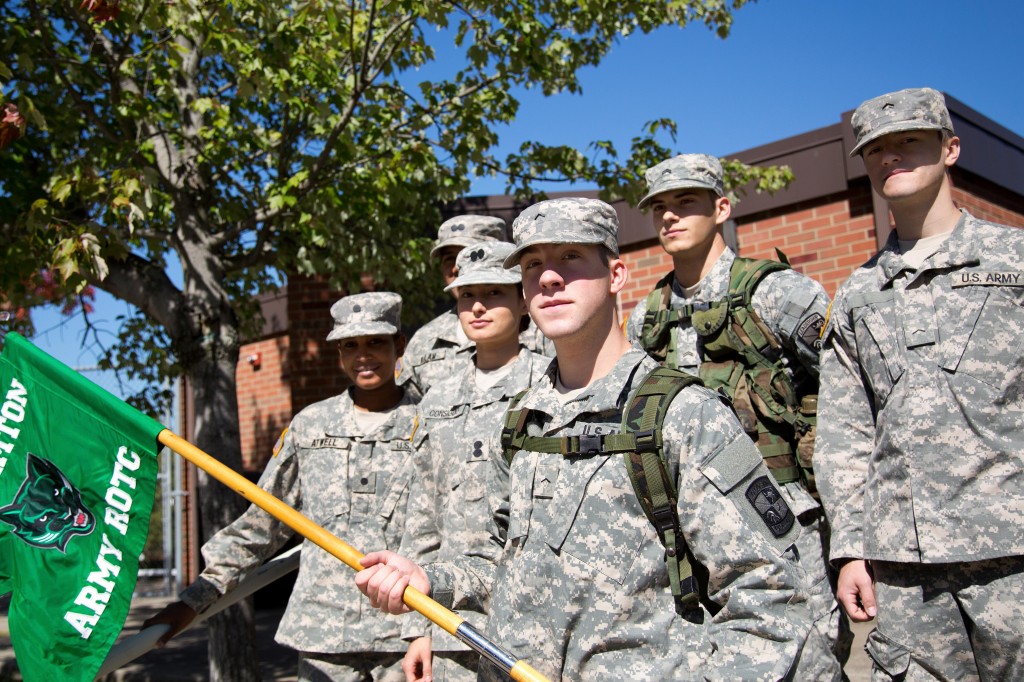
The relatively low-profile Army Reserve Officers’ Training Corps at Binghamton University is trying to expand in size and reputation, alongside a campus trying to accomplish the same thing.
Senior military science instructor Adam Ciacelli, who has run the ROTC program since September, said that the growing population at BU is forcing the program to adapt itself to fit the changing needs of the students.
“One of the challenges that we’ve found is transitioning to a growing, up-and-coming university, being able to outreach to new programs, to new students that are coming on board and being able to assist them with scholarships and being able to sell our brand as something that’s viable to help them and accomplish their goal,” Ciacelli said.
Ciacelli estimated that the ROTC program has grown by three or four students in the past five to 10 years, but according to the Office of Internal Research, the University itself has grown by 1,500 undergraduate students since 2002.
“It’s a growing campus, and our program hasn’t grown with the population,” Ciacelli said.
Despite this, BU’s program, with 22 enrolled cadets, is the largest out of the Cornell Excelsior group, which also includes Cornell University, Elmira College, Ithaca College and SUNY Cortland.
ROTC at BU offers three to four scholarships per graduating class to students contracting a “one to one” active duty commitment, meaning that a four-year scholarship from ROTC will equate to a four-year commitment as a full-time officer in the Army, according to Ciacelli.
There is nearly an unlimited number of Guaranteed Reserve Forces Duty scholarships available to students who opt for a “one to two” commitment, in which a four-year scholarship is matched by an eight-year commitment to the Reserves, enabling students to use their degrees after college in a civilian job while still working for the army on a part-time basis.
There is, however, an option available that will enable more students to become a part of the program through degree-specific scholarships that are separate from the limited number of general active duty scholarships.
“We offer mechanical engineering, engineering, science and technical scholarships for students that have a mathematical or science based degree set aside just for them so they can join and be an active member of the ROTC,” Ciacelli said. “So for recruitment purposes we sit on a growing campus that we have not even touched as far as maximizing the potential for scholarships and the program.”
Ciacelli said that color guard events like those held on Veteran’s Day, which ROTC runs with University President Harvey Stenger, help the program have a presence on campus. ROTC is also acquiring permanent classroom space in the Appalachian Collegiate Center to hold classes required for first- and second-year cadets.
“For the first two years, it’s open to all of campus without any obligation to the military,” Ciacelli said. “It’s free of charge, and it could end up paying you large dividends.”
Ciacelli noted that not everyone can make the same commitments, and recruitment is different for each cadet, something ROTC tries to respect.
“This program is not cookie cutter, and each person brings something new and unique to the Army, to the ROTC and to Binghamton campus, so that can’t be ignored,” Ciacelli said.
Tanvir Kalam, a senior majoring in Arabic, said that although he has had to make sacrifices for ROTC, it has been an “enriching” experience that has made him more organized, determined and professional.
“Being an ROTC cadet and a student at the same time is a juggling act, a feat in time management and being able to function without adequate sleep,” Kalam wrote in an email. “There have been dozens of instances where I haven’t been able to go out with my friends due to an Army commitment the next morning.”
Kalam likes ROTC’s low profile on campus.
“I think ROTC keeps a low key on campus simply because it is so small; and to be honest I see nothing wrong with that,” Kalam said. “All my close friends know that I’m in it and that’s enough for me. I am fine with its level of recognition now around campus, [if it was any] more, or less, popular I don’t think it would have an effect on the lives of the cadets involved.”


